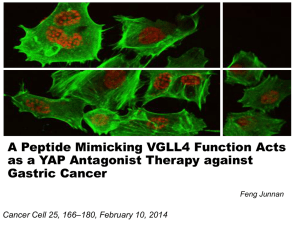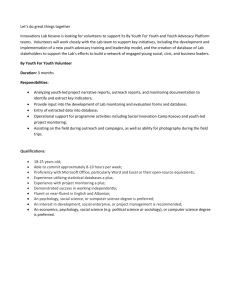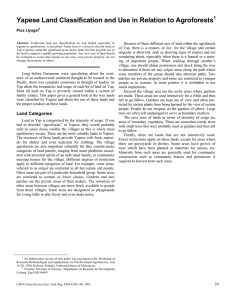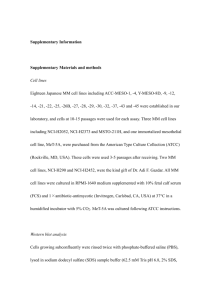Genetic and pharmacological disruption of the TEAD–YAP complex suppresses
advertisement
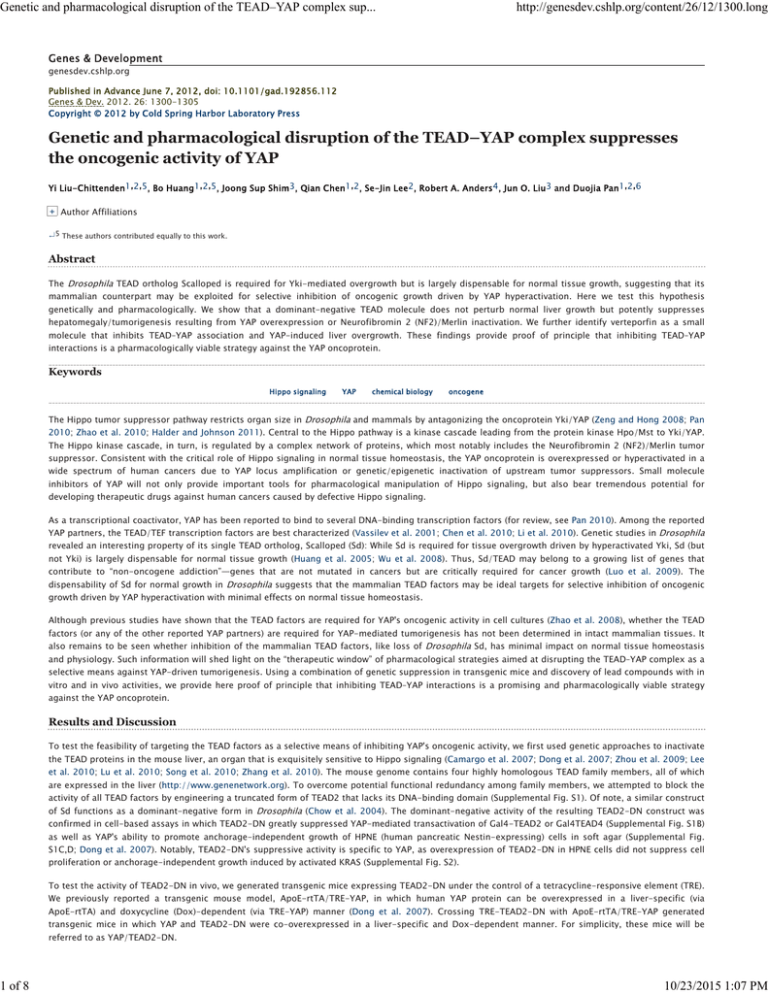
Genetic and pharmacological disruption of the TEAD–YAP complex sup...
1 of 8
http://genesdev.cshlp.org/content/26/12/1300.long
Genes & Development
genesdev.cshlp.org
Published in Advance June 7, 2012, doi: 10.1101/gad.192856.112
Genes & Dev. 2012. 26: 1300-1305
Copyright © 2012 by Cold Spring Harbor Laboratory Press
Genetic and pharmacological disruption of the TEAD–YAP complex suppresses
the oncogenic activity of YAP
Yi Liu-Chittenden1,2,5, Bo Huang1,2,5, Joong Sup Shim3, Qian Chen1,2, Se-Jin Lee2, Robert A. Anders 4, Jun O. Liu3 and Duojia Pan1,2,6
+ Author Affiliations
↵5 These authors contributed equally to this work.
Abstract
The Drosophila TEAD ortholog Scalloped is required for Yki-mediated overgrowth but is largely dispensable for normal tissue growth, suggesting that its
mammalian counterpart may be exploited for selective inhibition of oncogenic growth driven by YAP hyperactivation. Here we test this hypothesis
genetically and pharmacologically. We show that a dominant-negative TEAD molecule does not perturb normal liver growth but potently suppresses
hepatomegaly/tumorigenesis resulting from YAP overexpression or Neurofibromin 2 (NF2)/Merlin inactivation. We further identify verteporfin as a small
molecule that inhibits TEAD–YAP association and YAP-induced liver overgrowth. These findings provide proof of principle that inhibiting TEAD–YAP
interactions is a pharmacologically viable strategy against the YAP oncoprotein.
Keywords
Hippo signaling
YAP
chemical biology
oncogene
The Hippo tumor suppressor pathway restricts organ size in Drosophila and mammals by antagonizing the oncoprotein Yki/YAP (Zeng and Hong 2008; Pan
2010; Zhao et al. 2010; Halder and Johnson 2011). Central to the Hippo pathway is a kinase cascade leading from the protein kinase Hpo/Mst to Yki/YAP.
The Hippo kinase cascade, in turn, is regulated by a complex network of proteins, which most notably includes the Neurofibromin 2 (NF2)/Merlin tumor
suppressor. Consistent with the critical role of Hippo signaling in normal tissue homeostasis, the YAP oncoprotein is overexpressed or hyperactivated in a
wide spectrum of human cancers due to YAP locus amplification or genetic/epigenetic inactivation of upstream tumor suppressors. Small molecule
inhibitors of YAP will not only provide important tools for pharmacological manipulation of Hippo signaling, but also bear tremendous potential for
developing therapeutic drugs against human cancers caused by defective Hippo signaling.
As a transcriptional coactivator, YAP has been reported to bind to several DNA-binding transcription factors (for review, see Pan 2010). Among the reported
YAP partners, the TEAD/TEF transcription factors are best characterized (Vassilev et al. 2001; Chen et al. 2010; Li et al. 2010). Genetic studies in Drosophila
revealed an interesting property of its single TEAD ortholog, Scalloped (Sd): While Sd is required for tissue overgrowth driven by hyperactivated Yki, Sd (but
not Yki) is largely dispensable for normal tissue growth (Huang et al. 2005; Wu et al. 2008). Thus, Sd/TEAD may belong to a growing list of genes that
contribute to “non-oncogene addiction”—genes that are not mutated in cancers but are critically required for cancer growth (Luo et al. 2009). The
dispensability of Sd for normal growth in Drosophila suggests that the mammalian TEAD factors may be ideal targets for selective inhibition of oncogenic
growth driven by YAP hyperactivation with minimal effects on normal tissue homeostasis.
Although previous studies have shown that the TEAD factors are required for YAP's oncogenic activity in cell cultures (Zhao et al. 2008), whether the TEAD
factors (or any of the other reported YAP partners) are required for YAP-mediated tumorigenesis has not been determined in intact mammalian tissues. It
also remains to be seen whether inhibition of the mammalian TEAD factors, like loss of Drosophila Sd, has minimal impact on normal tissue homeostasis
and physiology. Such information will shed light on the “therapeutic window” of pharmacological strategies aimed at disrupting the TEAD–YAP complex as a
selective means against YAP-driven tumorigenesis. Using a combination of genetic suppression in transgenic mice and discovery of lead compounds with in
vitro and in vivo activities, we provide here proof of principle that inhibiting TEAD–YAP interactions is a promising and pharmacologically viable strategy
against the YAP oncoprotein.
Results and Discussion
To test the feasibility of targeting the TEAD factors as a selective means of inhibiting YAP's oncogenic activity, we first used genetic approaches to inactivate
the TEAD proteins in the mouse liver, an organ that is exquisitely sensitive to Hippo signaling (Camargo et al. 2007; Dong et al. 2007; Zhou et al. 2009; Lee
et al. 2010; Lu et al. 2010; Song et al. 2010; Zhang et al. 2010). The mouse genome contains four highly homologous TEAD family members, all of which
are expressed in the liver (http://www.genenetwork.org). To overcome potential functional redundancy among family members, we attempted to block the
activity of all TEAD factors by engineering a truncated form of TEAD2 that lacks its DNA-binding domain (Supplemental Fig. S1). Of note, a similar construct
of Sd functions as a dominant-negative form in Drosophila (Chow et al. 2004). The dominant-negative activity of the resulting TEAD2-DN construct was
confirmed in cell-based assays in which TEAD2-DN greatly suppressed YAP-mediated transactivation of Gal4-TEAD2 or Gal4TEAD4 (Supplemental Fig. S1B)
as well as YAP's ability to promote anchorage-independent growth of HPNE (human pancreatic Nestin-expressing) cells in soft agar (Supplemental Fig.
S1C,D; Dong et al. 2007). Notably, TEAD2-DN's suppressive activity is specific to YAP, as overexpression of TEAD2-DN in HPNE cells did not suppress cell
proliferation or anchorage-independent growth induced by activated KRAS (Supplemental Fig. S2).
To test the activity of TEAD2-DN in vivo, we generated transgenic mice expressing TEAD2-DN under the control of a tetracycline-responsive element (TRE).
We previously reported a transgenic mouse model, ApoE-rtTA/TRE-YAP, in which human YAP protein can be overexpressed in a liver-specific (via
ApoE-rtTA) and doxycycline (Dox)-dependent (via TRE-YAP) manner (Dong et al. 2007). Crossing TRE-TEAD2-DN with ApoE-rtTA/TRE-YAP generated
transgenic mice in which YAP and TEAD2-DN were co-overexpressed in a liver-specific and Dox-dependent manner. For simplicity, these mice will be
referred to as YAP/TEAD2-DN.
10/23/2015 1:07 PM
Genetic and pharmacological disruption of the TEAD–YAP complex sup...
2 of 8
http://genesdev.cshlp.org/content/26/12/1300.long
We showed previously that induction of YAP overexpression starting at 3 wk of age leads to a robust and uniform expansion of liver size, whereas induction
of YAP overexpression starting at birth leads to widespread development of hepatocellular carcinoma (HCC) (Dong et al. 2007). We used these experimental
regimes to test the efficacy of TEAD2-DN in blocking YAP-induced overgrowth and tumorigenesis. In mice subjected to Dox treatment starting at 3 wk of
age, expression of TEAD2-DN potently suppressed YAP-induced liver overgrowth (Fig. 1A,B,E), whereas in mice subjected to Dox treatment starting at birth,
expression of TEAD2-DN completely abolished YAP-induced HCC formation (Fig. 1C–E). Expression of TEAD2-DN also greatly improved animal survival; in
contrast to YAP transgenic mice, which had a mean survival of 7 wk after Dox treatment starting at 3 wk of age, YAP/TEAD2-DN mice showed 100% survival
during a 15-wk treatment (Fig. 1F). Unlike YAP-overexpressing livers, in which hepatocytes are smaller and more densely packed than wild type,
YAP/TEAD2-DN livers contained hepatocytes of normal size (Fig. 1B), suggesting that TEAD2-DN may suppress YAP's ability to promote cell proliferation
and/or survival. Indeed, YAP/TEAD2-DN livers showed greatly reduced BrdU incorporation compared with YAP livers (Supplemental Fig. S3A,D).
Furthermore, unlike YAP-overexpressing livers, which were resistant to Jo-2 (a Fas agonist)-induced hepatocellular apoptosis (Dong et al. 2007), Jo-2
treatment induced similar levels of apoptosis in YAP/TEAD2-DN and wild-type livers, as revealed by the widespread hemorrhage and apoptotic nuclei in
liver histology and caspase 3 cleavage (Supplemental Fig. S3B,C). Thus, TEAD2-DN suppressed YAP's proproliferative and anti-apoptotic activities. At mRNA
levels, TEAD2-DN reversed the up-regulation of genes that have previously been reported to be transcriptionally induced in YAP transgenic livers, including
Afp, Birc5/survivin, c-Myc, Sox4, Ctgf, Opn, Epcam, and Gpc3 (Supplemental Fig. S3E; Dong et al. 2007). Thus, TEAD2-DN can restore YAP-induced gene
transcription to wild-type levels.
Figure 1.
TEAD2-DN suppressed hepatomegaly and tumorigenesis driven by YAP overexpression. (A,B) Whole
amount (A) and hematoxylin/eosin (H&E) staining (B) of livers from wild-type (WT), YAP, and
YAP/TEAD2-DN mice treated with 0.2 g/L Dox for 2 wk starting at 3 wk of age. Bar, 1 cm. (C,D) similar to
A and B except that mice were treated with 1 g/L Dox for 8 wk starting at birth. (E) Quantification of
liver-to-body weight ratio for animals analyzed in A and C. Values are mean ± SEM; n ≥ 3 for each data
point. (F) Survival curves of wild-type, YAP, and YAP/TEAD2-DN mice subjected to 0.2 g/L Dox treatment
starting at 3 wk of age.
View larger version:
In this page
In a new window
Download as PowerPoint Slide
A trivial explanation for the observed suppression of YAP-induced phenotypes by TEAD2-DN is that TEAD2-DN may somehow reduce the expression of the
YAP transgene in the double-transgenic livers. We attempted to exclude this possibility by comparing YAP protein levels in YAP versus YAP/TEAD2-DN
livers. On the contrary, however, we found that YAP/TEAD2-DN livers always showed significantly increased levels of YAP proteins compared with YAP
transgenic livers, irrespective of the length of Dox treatment (Supplemental Fig. S4A). Quantitative real-time PCR analysis revealed similar levels of human
YAP mRNA (from the YAP transgene) and endogenous mouse Yap mRNA in both genotypes (Supplemental Fig. S4B), suggesting that TEAD2-DN may
increase YAP protein levels through a post-transcriptional mechanism; for example, by binding and stabilizing YAP. We tested this hypothesis in HEK293
cells. Indeed, when a GFP-tagged YAP was coexpressed with an increasing amount of HA-tagged TEAD2 or TEAD2-DN, both the exogenous GFP-YAP and
the endogenous YAP protein levels were increased (Supplemental Fig. S4C). We also compared the half-life of wild-type YAP and YAPS94A, a mutant form of
YAP that is defective in TEAD binding (Zhao et al. 2008). YAPS94A had a shorter half-life than wild-type YAP (Supplemental Fig. S4D), further supporting a
role for TEAD in binding and stabilizing YAP.
Next, we tested TEAD2-DN in NF2/Merlin-deficient livers, wherein liver overgrowth and tumorigenesis is driven by activation of endogenous YAP, rather
than overexpression of exogenous YAP (Zhang et al. 2010). For this purpose, we generated Alb-Cre; Nf2flox2/flox2; Alb-rtTA; TEAD2-DN mice (abbreviated
as Nf2 TEAD2-DN for simplicity) in which TEAD2-DN can be expressed in a Dox-dependent manner in Nf2 mutant livers. Two Dox treatment regimes were
used: a 7-wk treatment starting at gestation, and a 1-yr treatment starting at birth. Expression of TEAD2-DN significantly suppressed the overgrowth of
Nf2 mutant livers in both conditions (Fig. 2A,B). In the 7-wk treatment group, TEAD2-DN abolished the development of bile duct hamartoma that were
otherwise detectable (with 100% penetrance) on the surface of Nf2 mutant liver lobes (Fig. 2A). In the 1-yr treatment group, Nf2-deficient livers typically
showed expansive bile duct hamartoma comprised of masses of cytokeratin (CK)-positive biliary epithelial cells (BECs) that have invaded deep into the liver
parenchyma, as well as HCC (with 100% penetrance) and greatly increased liver weight (Fig. 2B–E). In 1-yr-old Nf2 TEAD2-DN livers, hamartoma
development was greatly suppressed and no HCC was observed (Fig. 2B–D), resulting in a liver size comparable with that of wild-type mice (Fig. 2E).
Consistent with phenotypic suppression, TEAD2-DN potently suppressed the up-regulation of YAP target genes in Nf2-deficient livers (Supplemental Fig.
S5) in much the same way that TEAD2-DN reversed the up-regulation of these genes in YAP-overexpressing livers (Supplemental Fig. S3E). Importantly,
overexpression of TEAD2-DN by itself (using Alb-rtTA; TRE-TEAD2-DN mice) did not affect liver size, liver histology, or expression of YAP target genes
(Supplemental Fig. S6). Thus, much like in Drosophila, where Sd is required for overgrowth driven by hyperactive Yki but is dispensable for normal growth in
most imaginal tissues, TEAD2-DN can prevent hepatomegaly and liver tumorigenesis caused by YAP hyperactivation without compromising normal liver
homeostasis.
Figure 2.
TEAD2-DN suppressed Nf2-deficient phenotypes in the liver. (A) Livers from wild-type, Nf2, and Nf2 TEAD2-DN mice subjected to 2 g/L Dox
treatment for 7 wk starting at gestation. Note the presence of thick hamartomas (arrowheads) at the edge of the Nf2 mutant liver. Only a remnant
hamartoma (arrowhead) was visible in the Nf2 TEAD2-DN liver. Bar, 1cm. (B) Similar to A except that mice were subjected to Dox treatment for 1
yr starting at birth. Note the massive overgrowth and the presence of multiple HCC (arrows) in the Nf2 mutant liver and the near-normal
appearance of the Nf2 TEAD2-DN liver. Note that bile duct hamartomas, which appeared first at the edge of the Nf2 mutant liver (shown in A),
have invaded deep into the liver parenchyma by 1 yr of age, giving the Nf2 mutant liver an overall pale color. Only a remnant hamartoma
(arrowhead) was visible in the Nf2 TEAD2-DN liver. (C,D) H&E (C) and CK (D) staining of liver sections from B. Note the presence of
deep-penetrating CK-positive bile duct hamartoma and CK-negative HCC in the Nf2 mutant liver. Also note the greatly reduced bile duct
10/23/2015 1:07 PM
Genetic and pharmacological disruption of the TEAD–YAP complex sup...
3 of 8
http://genesdev.cshlp.org/content/26/12/1300.long
hyperplasia and the absence of HCC in the Nf2 TEAD2-DN liver. (E) Quantification of liver-to-body
weight ratio for animals analyzed in A and B. (7WG) Dox treatment for 7 wk starting at gestation; (1YB)
Dox treatment for 1 yr starting at birth. n ≥ 6 for each data point. In both conditions, the overgrowth of
Nf2 mutant livers was significantly suppressed in Nf2 TEAD2-DN livers (P = 1 × 10−5 and 1 × 10−7,
respectively).
View larger version:
In this page
In a new window
Download as PowerPoint Slide
The striking ability of TEAD2-DN to suppress hepatomegaly and liver tumorigenesis caused by YAP overexpression or loss of NF2, combined with the
inconsequentiality of TEAD2-DN on normal liver homeostasis, suggests that the TEAD–YAP transcription factor complex may offer an ideal drug target for
selective inhibition of YAP-induced tumorigenesis. Thus, small molecules that inhibit the physical association between YAP and TEAD may provide a
pharmacological approach for inhibiting TEAD function. To screen for such inhibitors, we took advantage of an established luciferase reporter assay in
which transcriptional activity of a Gal4-TEAD4 fusion is stimulated by YAP (Zhao et al. 2008). Using this reporter assay, we screened the Johns Hopkins Drug
Library, a collection of >3300 drugs that have been approved by the United States Food and Drug Administration or its foreign counterparts or have entered
phase II clinical trials (Chong et al. 2007). We identified 71 hits that inhibited luciferase activity by >30% at a concentration of 10 μM (Fig. 3A). Three
compounds (protoporphyrin IX [PPIX], hematoporphyrin [HP], and verteporfin [VP]) stood out among the top hits, as they all belong to the porphyrin family,
which are aromatic heterocyclic cyclic molecules composed of four modified pyrrole units interconnected at their α carbon atoms via methine bridges.
Coincidently, the same three porphyrin molecules were also identified as top hits in an independent FRET-based Yki–Sd interaction screen (data not shown).
To confirm that these hits indeed disrupted physical interactions between YAP and TEAD, we performed coimmunoprecipitation (co-IP) assays in HEK293
cells expressing GAL4-TEAD4 and HA-YAP that had been treated with the test compounds at various concentrations or the solvent control DMSO (Fig. 3B).
While treatment with HP did not cause appreciable inhibition at 10 μM (data not shown), treating cells with the other two porphyrins (VP and PPIX) at 10 μM
dramatically reduced the amount of GAL4-TEAD recovered in the immunoprecipitates of HA-YAP, indicating that these two drugs significantly disrupted
YAP–TEAD interactions (Fig. 3B). Interestingly, VP displayed stronger inhibitory effects than PPIX, as >50% inhibition could still be observed when VP was
titrated down to 2.5 μM, while 5 μM PPIX had negligible effects. Thus, we identified VP and PPIX as the first small molecule inhibitors targeting the physical
interactions between YAP and TEAD.
Figure 3.
Identification of VP and related porphyrin compounds as inhibitors of TEAD–YAP interactions. (A) Plot
showing distribution of luciferase activity of HEK293 cells expressing Gal4-TEAD4/YAP/UAS-Luc and
treated with individual Hopkins Library compounds at 10 μM. All three porphyrin derivatives from the
library (PPIX, HP, and VP) were scored as hit compounds as circled. A schematic drawing of the luciferase
assay is also shown. (B) Inhibition of TEAD–YAP interaction by VP and PPIX. HEK293 cells expressing
Gal4-TEAD4 and HA-YAP were incubated with the indicated concentrations of each chemical, and the
presence of Gal4-TEAD in the HA-YAP immunoprecipitates was probed. The chemical structures of VP
and PPIX are also shown. (C) VP binds to purified YAP in vitro. Purified YAP (5 μM) (left) or TEAD2 (5 μM)
View larger version:
In this page
In a new window
Download as PowerPoint Slide
(right) was incubated with VP (15 μM) for 15 min at room temperature. The mixture was then fractioned
through a size exclusion column, and the VP fluorescence was measured in each fraction. Note that an
appreciable VP fluorescence coeluted with the YAP protein peak (fraction 45, left) but not with the TEAD2
protein peak (fraction 54, right). (D) Effect of VP on trypsin cleavage of YAP or TEAD2. Purified YAP or
TEAD2 (5 μM) was preincubated with DMSO (D) or 20 μM VP (V) for 30 min at room temperature prior to
trypsin digestion for the indicated time. The cleavage products were analyzed by Coomasie brilliant blue
staining after SDS-PAGE. (E) Effect of different concentrations of VP on trypsin cleavage of YAP. YAP (5 μM) was preincubated with various
concentrations of VP for 30 min at room temperature, followed by incubation with (+) or without (−) trypsin (0.1 μg/mL) for 1 h on ice. The
graph shows quantification of uncleaved versus input YAP at various VP concentrations.
VP (trade name Visudyne by Novartis) is used clinically as a photosensitizer in photodynamic therapy for neovascular macular degeneration, where it is
activated by a special wavelength laser light to generate reactive oxygen radicals that eliminate the abnormal blood vessels (Michels and Schmidt-Erfurth
2001). The inhibitory activity of VP on YAP–TEAD interactions apparently did not require light activation, since all of our binding assays were conducted in
darkness. To investigate how VP inhibits YAP–TEAD interactions, we determined whether VP directly binds to purified YAP or TEAD protein, taking advantage
of porphyrin's intrinsic fluorescence emission (Rotomskis et al. 1989). Bacterially purified YAP or TEAD2 was incubated with VP, and the mixture was then
analyzed on a size exclusion column to examine whether VP coelutes with either protein. An appreciable VP fluorescence coeluted with the YAP protein peak
but not with the TEAD2 protein peak, demonstrating that VP selectively binds YAP (Fig. 3C).
We further investigated the binding of VP to YAP or TEAD2 by analyzing proteolytic profiles of the respective protein in the presence of VP, a method that is
widely used to determine binding of a small molecule to its target protein and to probe conformational changes of proteins (Yun et al. 2004). Direct binding
of a small molecule to a protein can cause conformational changes that are accompanied by alteration in proteolysis patterns of the protein by proteases
such as trypsin. Under the optimal cleavage conditions for each protein, 20 μM VP significantly enhanced the trypsin cleavage of YAP over time, while it had
no effect on the cleavage of TEAD2 (Fig. 3D). In addition, VP dose-dependently accelerated trypsin cleavage of YAP with an EC50 (half maximal effective
concentration) value of 0.1 μM (Fig. 3E). These results suggest that VP binds to YAP and enhances the accessibility of trypsin to YAP, presumably by
10/23/2015 1:07 PM
Genetic and pharmacological disruption of the TEAD–YAP complex sup...
4 of 8
http://genesdev.cshlp.org/content/26/12/1300.long
changing the conformation of YAP. Taken together, we conclude that VP binds to YAP and changes its conformation, thereby abrogating its interaction with
TEAD2.
Given the considerable functional conservation between the mammalian TEAD–YAP complex and its Drosophila counterpart, we tested whether the
porphyrins could inhibit the Yki–Sd complex in Drosophila cells. S2R+ cells expressing Myc-Yki and HA-Sd were treated with VP or PPIX, and the amount of
HA-Sd recovered in the Myc-Yki immunoprecipitates was measured as an indication of Sd–Yki association. Consistent with their relative potencies against
the TEAD–YAP complex in mammalian cells, VP exhibited robust dose-dependent inhibition of Sd–Yki interaction that became apparent at 200 nM, whereas
PPIX showed a milder inhibitory effect than VP, with an estimated IC50 (half maximal inhibitory concentration) between 5 and 10 μM (Supplemental Fig.
S7A). VP also inhibited the interaction between endogenous Yki and transiently expressed HA-Sd in S2 cells (Supplemental Fig. S7B). Interestingly, we noted
that VP treatment of S2 cells led to a reduction in protein and mRNA levels of endogenous diap1, a direct transcription target of Yki (Supplemental Fig. S7B).
These results demonstrate that VP induces transcriptional changes in Drosophila cells that are consistent with inhibition of the Sd–Yki complex.
Next, we examined the ability of VP to inhibit the oncogenic activity of YAP in vivo using two independent assays. In the first assay, we tested VP's ability to
suppress YAP-induced hepatomegaly using the inducible YAP transgenic mouse model described above. The ApoE-rtTA/TRE-YAP mice were injected with
VP (100 mg/kg) every other day over a period of 8 d, while these mice were kept on Dox throughout the course of experiment (Fig. 4A). Compared with the
control group (Dox+DMSO), the VP-treated group (Dox+VP) exhibited a smaller increase in liver size and a decreased number of mitotic cells (Fig. 4B,C).
Importantly, VP treatment did not interfere with YAP transgene expression (Supplemental Fig. S8A) or affect liver size in wild-type control (i.e.,
nontransgenic) mice (Supplemental Fig. S8B). In the second assay, we tested VP in mice bearing liver-specific knockout of NF2/Merlin, which exhibited bile
duct overproliferation due to activation of endogenous YAP (Zhang et al. 2010). Pregnant mothers bearing Alb-Cre; Nf2flox2/flox2 embryos received VP
injections (100 mg/kg) every other day starting at embryonic day 9 (E9) of the Alb-Cre; Nf2flox2/flox2 embryos until birth (Fig. 4D), and BECs were visualized
by CK staining at E18.5. As shown in Figure 4E, the number of CK-positive BECs was significantly reduced in VP-treated Nf2-deficent livers compared with
control-treated Nf2-deficient livers. Thus, VP suppressed liver overgrowth resulting from either YAP overexpression or activation of endogenous YAP. These
results are encouraging, since VP is a clinically applied drug with little side effects, and our results were obtained using an aqueous preparation in which VP
bioavailability is suboptimal compared with the lipid-based formulation used in Visudyne.
Figure 4.
VP suppressed liver overgrowth caused by YAP overexpression or inactivation of Nf2. (A) Experimental
design. Three-week-old YAP transgenic mice were fed 20 mg/L Dox for 8 d. VP suspension (100 mg/kg)
was administered by intraperitoneal injection once every other day during the 8-d period. (B) Livers from
View larger version:
In this page
In a new window
Download as PowerPoint Slide
control (Dox+DMSO; left picture) and VP-treated (Dox+VP; right picture) YAP transgenic mice (left) and
quantification of liver-to-body weight ratio (right) at the end of the 8-d period. The VP-treated mice had
significantly smaller livers than control livers (7.3% vs. 8.9%, n = 5 in each group, P < 0.001, t-test). (C)
Phospho-H3 (PH3) staining of liver sections (left) and quantification of PH3-positive cells (right) of liver
sections from B. (D) Experimental design. Timed pregnant Nf2flox2/flox2 mothers (after mating with
Alb-Cre; Nf2flox2/flox2 males) received intraperitoneal injection of VP (100 mg/kg) or DMSO every other
day starting at 9 d after detection of vaginal plugs (corresponding to E9.5 for embryos carried by the pregnant mothers). Newborn pups
(corresponding to E18.5) were analyzed for liver phenotypes. (E) CK staining of liver sections from E18.5 Alb-Cre; Nf2flox2/flox2 pups that had
been subjected to control (DMSO) (left) or VP (right) treatment from E9.5 to E18.5. The graph shows quantification of CK-positive BECs.
A major challenge in cancer research is the identification of cellular targets whose inhibitions selectively impair the growth of cancer cells while sparing
normal cells (Luo et al. 2009). We demonstrate here that one can exploit the intrinsic property of a growth regulatory pathway; namely, the preferential
requirement of TEAD/TEF transcription factors for oncogenic over normal growth as a selective means to inhibit YAP-induced tumorigenesis. The
inconsequentiality of TEAD2-DN on normal liver homeostasis suggests that this strategy may offer an excellent “therapeutic window” with minimal adverse
effects. As a proof of principle for this approach, we conducted a pilot screen and identified VP as a small molecule that inhibits TEAD–YAP interactions and
prevents YAP-induced oncogenic growth. Whether VP or its derivatives are effective on pre-established tumors awaits future investigation. Finally, the
efficacy of TEAD2-DN and VP in suppressing Nf2-deficient phenotypes lends further support for a functional link between NF2/Merlin and Hippo signaling
(Hamaratoglu et al. 2006; Zhang et al. 2010) and offers the promise of YAP inhibitors as molecular targeted therapeutics for NF2, a genetic disorder caused
by inactivation of the NF2/Merlin tumor suppressor.
Materials and methods
Chemical screen
Twenty-five-thousand HEK293 cells per well in 96-well plates were transfected (Effectene, Qiagen) with 8 ng of pHA-YAP, pGal4-TEAD4, and 5× UAS-Luc
and 0.4 ng of Pol III renilla luciferase. Library compounds were dispensed into each well immediately after transfection at a final concentration of 10 μM.
After 16 h, cell lysates were examined for firefly luciferase activity relative to renilla luciferase with the Dual-Luciferase Reporter Assay kit (Promega) and a
FLUOstar OPTIMA microplate reader (BMG).
Acknowledgments
This study was supported in part by grants from the NIH (R01EY015708 to D.P., R01AR060636 to S.-J.L., R01DK081417 to R.A.A., and R01CA122814 to
J.O.L.) and FARMRI (to J.O.L). D.P. is an investigator of the Howard Hughes Medical Institute.
Footnotes
↵6 Corresponding author
E-mail djpan@jhmi.edu
10/23/2015 1:07 PM
Genetic and pharmacological disruption of the TEAD–YAP complex sup...
5 of 8
http://genesdev.cshlp.org/content/26/12/1300.long
Supplemental material is available for this article.
Article published online ahead of print. Article and publication date are online at http://www.genesdev.org/cgi/doi/10.1101/gad.192856.112.
Received March 26, 2012.
Accepted May 11, 2012.
Copyright © 2012 by Cold Spring Harbor Laboratory Press
References
Camargo FD, Gokhale S, Johnnidis JB, Fu D, Bell GW, Jaenisch R, Brummelkamp TR. 2007. YAP1 increases organ size and expands undifferentiated
progenitor cells. Curr Biol 17: 2054–2060. CrossRef Medline Web of Science
Chen L, Chan SW, Zhang X, Walsh M, Lim CJ, Hong W, Song H. 2010. Structural basis of YAP recognition by TEAD4 in the hippo pathway. Genes Dev 24:
290–300. Abstract/FREE Full Text
Chong CR, Xu J, Lu J, Bhat S, Sullivan DJ Jr., Liu JO. 2007. Inhibition of angiogenesis by the antifungal drug itraconazole. ACS Chem Biol 2: 263–270.
CrossRef
Medline
Web of Science
Chow L, Berube J, Fromont A, Bell JB. 2004. Ability of scalloped deletion constructs to rescue sd mutant wing phenotypes in Drosophila melanogaster.
Genome 47: 849–859. Medline
Dong J, Feldmann G, Huang J, Wu S, Zhang N, Comerford SA, Gayyed MF, Anders RA, Maitra A, Pan D. 2007. Elucidation of a universal size-control
mechanism in Drosophila and mammals. Cell 130: 1120–1133. CrossRef Medline Web of Science
Halder G, Johnson RL. 2011. Hippo signaling: Growth control and beyond. Development 138: 9–22.
Abstract/FREE Full Text
Hamaratoglu F, Willecke M, Kango-Singh M, Nolo R, Hyun E, Tao C, Jafar-Nejad H, Halder G. 2006. The tumour-suppressor genes NF2/Merlin and
Expanded act through Hippo signalling to regulate cell proliferation and apoptosis. Nat Cell Biol 8: 27–36. CrossRef Medline Web of Science
Huang J, Wu S, Barrera J, Matthews K, Pan D. 2005. The Hippo signaling pathway coordinately regulates cell proliferation and apoptosis by inactivating
Yorkie, the Drosophila homolog of YAP. Cell 122: 421–434. CrossRef Medline Web of Science
Lee KP, Lee JH, Kim TS, Kim TH, Park HD, Byun JS, Kim MC, Jeong WI, Calvisi DF, Kim JM, et al. 2010. The Hippo-Salvador pathway restrains hepatic oval cell
proliferation, liver size, and liver tumorigenesis. Proc Natl Acad Sci 107: 8248–8253. Abstract/FREE Full Text
Li Z, Zhao B, Wang P, Chen F, Dong Z, Yang H, Guan KL, Xu Y. 2010. Structural insights into the YAP and TEAD complex. Genes Dev 24: 235–240.
Abstract/FREE Full Text
Lu L, Li Y, Kim SM, Bossuyt W, Liu P, Qiu Q, Wang Y, Halder G, Finegold MJ, Lee JS, et al. 2010. Hippo signaling is a potent in vivo growth and tumor
suppressor pathway in the mammalian liver. Proc Natl Acad Sci 107: 1437–1442. Abstract/FREE Full Text
Luo J, Solimini NL, Elledge SJ. 2009. Principles of cancer therapy: Oncogene and non-oncogene addiction. Cell 136: 823–837.
Web of Science
CrossRef
Medline
Michels S, Schmidt-Erfurth U. 2001. Photodynamic therapy with verteporfin: A new treatment in ophthalmology. Semin Ophthalmol 16: 201–206.
CrossRef
Medline
Pan D. 2010. The hippo signaling pathway in development and cancer. Dev Cell 19: 491–505.
CrossRef
Medline
Web of Science
Rotomskis R, van de Meent EJ, Aartsma TJ, Hoff AJ. 1989. Fluorescence spectra of hematoporphyrin and hematoporphyrin-diacetate aggregates in buffer
solution. J Photochem Photobiol B 3: 369–377. CrossRef Medline
Song H, Mak KK, Topol L, Yun K, Hu J, Garrett L, Chen Y, Park O, Chang J, Simpson RM, et al. 2010. Mammalian Mst1 and Mst2 kinases play essential roles
in organ size control and tumor suppression. Proc Natl Acad Sci 107: 1431–1436. Abstract/FREE Full Text
Vassilev A, Kaneko KJ, Shu H, Zhao Y, DePamphilis ML. 2001. TEAD/TEF transcription factors utilize the activation domain of YAP65, a Src/Yes-associated
protein localized in the cytoplasm. Genes Dev 15: 1229–1241. Abstract/FREE Full Text
Wu S, Liu Y, Zheng Y, Dong J, Pan D. 2008. The TEAD/TEF family protein Scalloped mediates transcriptional output of the Hippo growth-regulatory
pathway. Dev Cell 14: 388–398. CrossRef Medline Web of Science
Yun BG, Huang W, Leach N, Hartson SD, Matts RL. 2004. Novobiocin induces a distinct conformation of Hsp90 and alters Hsp90-cochaperone-client
interactions. Biochemistry 43: 8217–8229. CrossRef Medline Web of Science
Zeng Q, Hong W. 2008. The emerging role of the hippo pathway in cell contact inhibition, organ size control, and cancer development in mammals. Cancer
Cell 13: 188–192. CrossRef Medline Web of Science
Zhang N, Bai H, David KK, Dong J, Zheng Y, Cai J, Giovannini M, Liu P, Anders RA, Pan D. 2010. The Merlin/NF2 tumor suppressor functions through the
YAP oncoprotein to regulate tissue homeostasis in mammals. Dev Cell 19: 27–38. CrossRef Medline Web of Science
Zhao B, Ye X, Yu J, Li L, Li W, Li S, Yu J, Lin JD, Wang CY, Chinnaiyan AM, et al. 2008. TEAD mediates YAP-dependent gene induction and growth control.
Genes Dev 22: 1962–1971. Abstract/FREE Full Text
Zhao B, Li L, Lei Q, Guan KL. 2010. The Hippo–YAP pathway in organ size control and tumorigenesis: An updated version. Genes Dev 24: 862–874.
Abstract/FREE Full Text
Zhou D, Conrad C, Xia F, Park JS, Payer B, Yin Y, Lauwers GY, Thasler W, Lee JT, Avruch J, et al. 2009. Mst1 and Mst2 maintain hepatocyte quiescence and
suppress hepatocellular carcinoma development through inactivation of the Yap1 oncogene. Cancer Cell 16: 425–438. CrossRef Medline Web of Science
Related Article
PERSPECTIVE:
Quit your YAPing: a new target for cancer therapy
Ben Z. Stanger
Genes Dev. June 15, 2012 26: 1263-1267; doi:10.1101/gad.196501.112
Abstract
Full Text
Full Text (PDF)
10/23/2015 1:07 PM
Genetic and pharmacological disruption of the TEAD–YAP complex sup...
6 of 8
http://genesdev.cshlp.org/content/26/12/1300.long
Articles citing this article
Hippo and TGF-{beta} interplay in the lung field
Am. J. Physiol. Lung Cell. Mol. Physiol. October 15, 2015 309: L756-L767
Abstract
Full Text
Full Text (PDF)
Interaction of the EGF Receptor and the Hippo Pathway in the Diabetic Kidney
J. Am. Soc. Nephrol. October 9, 2015 0: ASN.2015040415v1-ASN.2015040415
Abstract
Tumor-selective proteotoxicity of verteporfin inhibits colon cancer progression independently of YAP1
Sci Signal October 6, 2015 8: ra98
Abstract
Full Text
Full Text (PDF)
Proteostasis trumps YAP in colon cancer
Sci Signal October 6, 2015 8: fs18
Abstract
Full Text
Full Text (PDF)
The Hippo/YAP pathway interacts with EGFR signaling and HPV oncoproteins to regulate cervical cancer progression
EMBO Mol Med. September 28, 2015 0: emmm.201404976v1-e201404976
Abstract
Full Text
Full Text (PDF)
Phosphorylation of the Hippo Pathway Component AMOTL2 by the mTORC2 Kinase Promotes YAP Signaling, Resulting in Enhanced
Glioblastoma Growth and Invasiveness
J Biol Chem August 7, 2015 290: 19387-19401
Abstract
Full Text
Full Text (PDF)
Searching for targets for the systemic therapy of mesothelioma
Ann Oncol August 1, 2015 26: 1649-1660
Abstract
Full Text
Full Text (PDF)
{beta}-Catenin destruction complex-independent regulation of Hippo-YAP signaling by APC in intestinal tumorigenesis
Genes Dev. July 15, 2015 29: 1493-1506
Abstract
Full Text
Full Text (PDF)
YAPing Hippo Forecasts a New Target for Lung Cancer Prevention and Treatment
JCO July 10, 2015 33: 2311-2313
Full Text
Full Text (PDF)
Deregulation of the Hippo pathway in soft-tissue sarcoma promotes FOXM1 expression and tumorigenesis
Proc. Natl. Acad. Sci. USA June 30, 2015 112: E3402-E3411
Abstract
Full Text
Full Text (PDF)
The Hippo Coactivator YAP1 Mediates EGFR Overexpression and Confers Chemoresistance in Esophageal Cancer
Clin. Cancer Res. June 1, 2015 21: 2580-2590
Abstract
Full Text
Full Text (PDF)
Mechanical strain induces E-cadherin-dependent Yap1 and {beta}-catenin activation to drive cell cycle entry
Science May 29, 2015 348: 1024-1027
Abstract
Full Text
Full Text (PDF)
Aerobic glycolysis tunes YAP/TAZ transcriptional activity
EMBO J. May 12, 2015 34: 1349-1370
Abstract
Full Text
Full Text (PDF)
Actin cytoskeletal remodeling with protrusion formation is essential for heart regeneration in Hippo-deficient mice
Sci Signal May 5, 2015 8: ra41
Abstract
Full Text
Full Text (PDF)
The Hippo Pathway Effector YAP Regulates Motility, Invasion, and Castration-Resistant Growth of Prostate Cancer Cells
Mol. Cell. Biol. April 15, 2015 35: 1350-1362
Abstract
Full Text
Full Text (PDF)
10/23/2015 1:07 PM
Genetic and pharmacological disruption of the TEAD–YAP complex sup...
7 of 8
http://genesdev.cshlp.org/content/26/12/1300.long
Targeting Hippo pathway by specific interruption of YAP-TEAD interaction using cyclic YAP-like peptides
FASEB J. February 1, 2015 29: 724-732
Abstract
Full Text
Full Text (PDF)
The regulation and function of YAP transcription co-activator
Acta Biochim Biophys Sin January 1, 2015 47: 16-28
Abstract
Full Text
Full Text (PDF)
Hippo signaling in epithelial stem cells
Acta Biochim Biophys Sin January 1, 2015 47: 39-45
Abstract
Full Text
Full Text (PDF)
Two-signal requirement for growth-promoting function of Yap in hepatocytes
elife January 1, 2015 4: e02948
G protein-coupled receptors: bridging the gap from the extracellular signals to the Hippo pathway
Acta Biochim Biophys Sin January 1, 2015 47: 10-15
Abstract
Full Text
Full Text (PDF)
Structural dissection of Hippo signaling
Acta Biochim Biophys Sin January 1, 2015 47: 29-38
Abstract
Full Text
Full Text (PDF)
Opposing activities of the Ras and Hippo pathways converge on regulation of YAP protein turnover
EMBO J. November 3, 2014 33: 2447-2457
Abstract
Full Text
Full Text (PDF)
Regulation of YAP by mTOR and autophagy reveals a therapeutic target of tuberous sclerosis complex
JEM October 20, 2014 211: 2249-2263
Abstract
Full Text
Full Text (PDF)
The Biology of YAP/TAZ: Hippo Signaling and Beyond
Physiol. Rev. October 1, 2014 94: 1287-1312
Abstract
Full Text
Full Text (PDF)
The Hippo signal transduction network in skeletal and cardiac muscle
Sci Signal August 5, 2014 7: re4
Abstract
Full Text
Full Text (PDF)
Hippo Coactivator YAP1 Upregulates SOX9 and Endows Esophageal Cancer Cells with Stem-like Properties
Cancer Res. August 1, 2014 74: 4170-4182
Abstract
Full Text
Full Text (PDF)
The Hippo signaling pathway in stem cell biology and cancer
EMBO Rep. June 1, 2014 15: 642-656
Abstract
Full Text
Full Text (PDF)
The Transcriptional Regulators TAZ and YAP Direct Transforming Growth Factor {beta}-induced Tumorigenic Phenotypes in Breast Cancer
Cells
J Biol Chem May 9, 2014 289: 13461-13474
Abstract
Full Text
Full Text (PDF)
Downstream of Mutant KRAS, the Transcription Regulator YAP Is Essential for Neoplastic Progression to Pancreatic Ductal Adenocarcinoma
Sci Signal May 6, 2014 7: ra42
Abstract
Full Text
Full Text (PDF)
Transcription and processing: multilayer controls of RNA biogenesis by the Hippo pathway
EMBO J. May 2, 2014 33: 942-944
Abstract
Full Text
Full Text (PDF)
A temporal requirement for Hippo signaling in mammary gland differentiation, growth, and tumorigenesis
Genes Dev. March 1, 2014 28: 432-437
Abstract
Full Text
Full Text (PDF)
10/23/2015 1:07 PM
Genetic and pharmacological disruption of the TEAD–YAP complex sup...
8 of 8
http://genesdev.cshlp.org/content/26/12/1300.long
CDK1 Phosphorylation of YAP Promotes Mitotic Defects and Cell Motility and Is Essential for Neoplastic Transformation
Cancer Res. November 15, 2013 73: 6722-6733
Abstract
Full Text
Full Text (PDF)
Hippo signaling disruption and Akt stimulation of ovarian follicles for infertility treatment
Proc. Natl. Acad. Sci. USA October 22, 2013 110: 17474-17479
Abstract
Full Text
Full Text (PDF)
Actin-related protein2/3 complex regulates tight junctions and terminal differentiation to promote epidermal barrier formation
Proc. Natl. Acad. Sci. USA October 1, 2013 110: E3820-E3829
Abstract
Full Text
Full Text (PDF)
Molecular Pathways: YAP and TAZ Take Center Stage in Organ Growth and Tumorigenesis
Clin. Cancer Res. September 15, 2013 19: 4925-4930
Abstract
Full Text
Full Text (PDF)
Intersection of Hippo/YAP and Wnt/{beta}-catenin signaling pathways
Acta Biochim Biophys Sin February 1, 2013 45: 71-79
Abstract
Full Text
Full Text (PDF)
The Hippo pathway target, YAP, promotes metastasis through its TEAD-interaction domain
Proc. Natl. Acad. Sci. USA September 11, 2012 109: E2441-E2450
Abstract
Full Text
Full Text (PDF)
10/23/2015 1:07 PM
